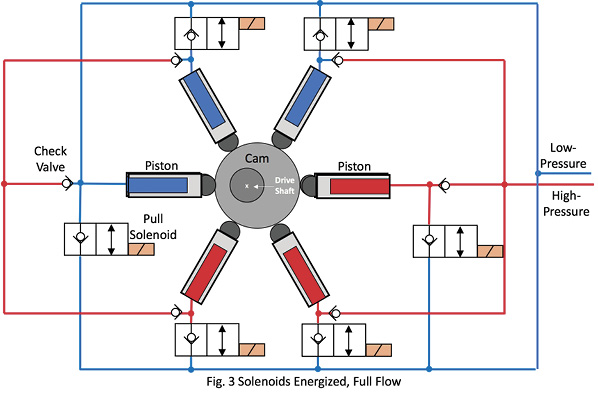You Made the Mess; Now You Clean It Up!
Now, don’t laugh, but I once designed a hydraulic system for automatically cleaning horse stalls using the energy from the movement of the waiting horse. I won’t get into the details, but I was going to market it with the slogan, “You made the mess, now you clean it up!”
When I think about the way we usually do off-line filtering and cooling, I was reminded of this. Our systems generate the particles and the heat that needs to be removed. So, why do we ask electric motors to drive our off-line filtering and temperature control systems? We already have a hydraulic power unit that probably has a slightly oversized electric motor and maybe even some significant dwell time. Why add to the inefficiency with another oversized electric motor? And, by the way, why not replace that electric fan motor on the heat exchanger with a hydraulic motor?
Let’s talk about it. Take an application where we have a 500-gallon reservoir and a system using a pressure-compensated pump set at 2000 psi. We have a high-pressure in-line filter and a return line filter, but there is a fair amount of dwell time and we want to have a kidney loop to “scrub” the hydraulic fluid. We want to exchange the reservoir volume four times an hour through an off-line filtration system. We do the math and find that we will need a pump that will flow about 30 gpm to accomplish this. Our filter has a 25-pound bypass spring, and so we know the resistive load on the pump will be less than 30 psi if we use the correct line size.
Now we have a decision to make. We do the math and we see that 30 gpm at 30 psi is going to be fractional HP. A 30-gpm pump coupled to a fractional HP motor is going to look a little silly, so we discard our calculator and apply a 5-hp, 1800-rpm electric motor to drive the 4.3-in.3 pump. We tell ourselves that we need the extra torque to start the pump and an oversized motor will run forever without any problem. The important thing is to clean and cool the fluid. No one is going to notice the little bit of energy consumed by the motor. It is simply the cost of properly conditioned fluid.
We have talked before about the fact that an oversized electric motor will waste energy (see the article on “Power Factor”). This system, running 24/7, will have an operating cost of about $1,100 per year, assuming a $.10/kWh cost of electricity. The waste will not show up in the heat load for the hydraulics, but it will add operating cost to the owner of the hydraulic power unit both in kW used and in the power factor charge from the power company. The installed cost will also have to include a bell housing, couplings, mounting pad, and an electrical panel with controls.
This brings us back to my first question. Why don’t we use a hydraulic motor to drive the pump? Think of some of the advantages. The motor and pump can be combined into one unit similar to a displacement flow divider/combiner. One section of the device would be the motor having a common internal shaft with the pump. The motor would have a displacement that would require almost all of the 2000 psi to develop the necessary torque to drive the pump. In this case a 0.1-in.3 motor would drive a 6.4-in.3 pump at 1200 rpm, and the combined flows would pass through the filtration system. The motor flow at 2000 psi would be about 0.5 gpm; little more than case drain flow. There is no bell housing, no coupling, and no electrical panel. The additional load on the hydraulic power unit would be about 0.44 kW at a cost of $400 per year—a savings of $700 per year over the electric motor. A ¼” tube from the pressure line with a simple flow limiter would be all the control necessary. When the main pump is running, the off-line filtration system is also working (Fig. 1).
We have an application here at the steel mill where we want to add some off-line filtration to our bulk storage. There would be a problem with the device described above because the flow through the hydraulic motor portion would be continually added to the bulk storage tank. The cure for this is simple. In this case, we would add a seal on the connecting shaft of the motor/pump and a return line from the motor back to the main reservoir. The seal is necessary because there is a normal internal leakage in the motor/pump and some fluid would continually be added to the bulk storage even if the motor had its own return line. The seal also provides the added advantage of allowing the use of different fluids for the motor and the pump. A power unit with one type of fluid could be used to drive the off-line filtration of another power unit or bulk storage having a different type of fluid (Fig. 2).
The next time we decide to add an off-line fluid conditioning system, we should consider doing it with fluid power. We made the mess, and we can clean it up.





